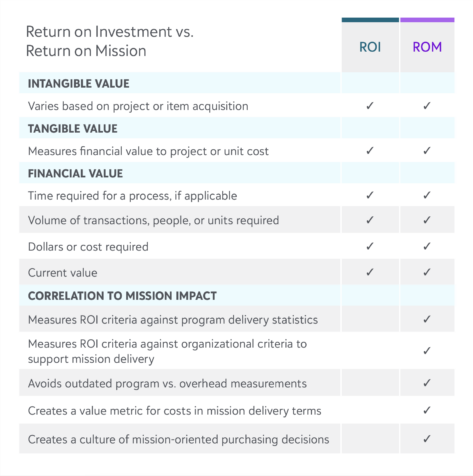Return on Mission: A Framework to Measure Success at Philanthropic Organizations

As a nonprofit organization, which factor do you believe best showcases the success of your mission?
- Overhead to program expense ratio
- Having money left over to reinvest at the end of the year
- Programmatic statistics related to mission impact
As with many multiple-choice tests, there is only one answer here that makes sense: programmatic statistics related to mission impact. Unfortunately, philanthropies are typically (and problematically) judged by the first two criteria.
As Chuck McLean and Suzanne E. Coffman stated in their GuideStar article:
“There’s no question that nonprofit organizations have an obligation to manage their finances responsibly. There’s also no question that ratios can be valuable tools for evaluating charitable groups. By themselves, however, these figures can be more misleading than helpful.”
In my 2024 book “Return on Mission: Translating Investment Into Mission Impact” I describe the five diverse motives that drive nonprofit, healthcare, higher education, and other institutions to purchase:
- Mission alignment
- Operation efficiency
- Quality and reliability
- Social and environmental responsibility
- Cost Considerations
These motives encompass so much more of the actual complexity that exists in an organization compared to the old-school program vs. overhead ratio measurement can capture. If we continue trying to measure social change by financial criteria alone, we’ll never have a full view of the inputs and processes necessary to create lasting impact. The solution for organizations is to look to a new formula that changes the discussion around these investments. That’s where Return on Mission comes in.
How Did We Get Here?
For years, we’ve used language from for-profit businesses to explain nonprofit organizational activity. However, using borrowed terms to communicate mission success has made it more difficult to explain the critical connection between the critical connection between financials, fundraising, and mission delivery.
There are undoubtedly for-profit business practices that we in the charity world use every day for the benefit of our employees and missions. However, we shouldn’t rely on for-profit output measures to paint a complete picture of nonprofit success.
For instance, the corporate profit-and-loss statement isn’t the same as our nonprofit budget-to-actuals report, and it falls short of providing the information necessary to effectively assess whether we need to course correct throughout the year.
To better understand the shortcomings of for-profit metrics as a true measure of nonprofit success, let’s look at how return on investment (ROI) is calculated.
ROI for Nonprofits
ROI is a cost/benefit analysis methodology that measures how much money is made or saved for a given investment and is calculated as:
ROI = (Gain from Investment – Cost of Investment / Cost of Investment) * 100
A sophisticated ROI calculation considers tangible and intangible items within the “Gain from Investment” part of the equation, while the “Cost of Investment” is the straightforward tabulation of pricing.
Tangible items include hard costs, revenue, or new customers gained. Intangible value created includes items such as brand awareness, customer satisfaction, and operational excellence.
This formula permeates many nonprofit board meetings as a means of calculating the value of an investment. And while this measure works to an extent for nonprofits to understand the direct financial benefits of an investment, on its own, it fails to connect those metrics—which are the business of charitable work—to the social impact of that same work.
I’ve personally had to define the word “nonprofit” to a fellow board member when he wanted to discuss the ROI on a free program we were implementing for individuals who couldn’t afford a specific treatment. We found common ground, but it took a while for him to get out of his for-profit mindset and think in terms of mission outcomes instead.
For years, I’ve advocated for one key change that would take a for-profit success measurement framework—ROI—a step further to provide a truly mission-focused measurement of nonprofit impact, return on mission® (ROM).
So, what are the differences between ROI and ROM? They share much of the same DNA, but the final step to correlate the formula outcome to mission impact is what creates ROM.
Transitioning from Return on Investment to Return on Mission®
The concept of ROM is that the real measure of a nonprofit’s success is not in how high the return is on an ‘investment,’ such as a grant or major gift, but rather how much that investment impacts the mission itself. That, then, is the bridge that connects overhead and mission costs.
A simple way to think of ROM is in this formula:
ROM = ROI Measurement / Proportionate Mission Cost
Many food banks know how much it costs to deliver X number of meals per day, week, month, or year. But why not go a step further and consider investments in the systems that provide support for the mission? Can a new financial management solution help drive better efficiency in meal delivery?
Surely a general ledger isn’t making meals, but it is driving the supply chain that brings in the items that become the meals, paying the expenses for those who work to prepare the meals, and keeping the lights on in the kitchen and dining hall to serve the meals.
For example, if an ROI on a new financial system can create $5,000 per year in savings, then as an organization, you can attribute a portion of that cost to mission delivery enhancements. Divide that ROI by your meal delivery statistic, and you have a ROM for that new solution that is attached to mission delivery.
This line of thinking will have you reconsider what you see as direct programmatic delivery. Is an expense management or purchasing solution part of mission delivery? Absolutely, if the mission can’t provide optimal program delivery without it.
As with the ROI formula itself, the simple examples never exactly mirror what you will encounter in real life, but a main goal to introducing the formula is to change the conversation around the investment.
“I truly love the immediate head nods of recognition I see when I talk to someone about the meaning of “Return on Mission”. There is a wonderful light bulb moment of understanding I can see in their eyes…It’s a simple realization in that the changing of one word changes everything about the term. A one-word change to a familiar tune changes the whole song. It is changed in a way that make the new song quick and easy to understand by people from many walks of life and experience.”
ROM provides accessible means to help put a term to how many, if not most, in our sector approach their work. It also provides a familiar means to highlight the differences in how our sector approaches our work compared to for-profit businesses.
From board discussions to setting organizational or departmental goals and more, I have heard firsthand how this simple change has focused discussions toward positive ends, short circuited many unhelpful conversations, and united teams in their purpose for projects.

Bringing Return on Mission Home
Organizations using ROM are better able to discuss, justify, and feel confident in their decisions to their staff, board members, funders, and other stakeholders. In doing so you will be creating your own shared dictionary of mission criteria that you can judge decisions against. You will have the elements to translate between and marry the business metrics that ROI measured and your mission impact criteria.
As you consider your next project, you, your internal project team, and your potential vendors all need to ask, “What’s the Return on Mission for this project?” If you can establish a positive ROM, then you have a project worth pushing forward. With ROM, we are measuring our mission’s work not by the outdated metrics of overhead/program or by for-profit business standards, but by the success of the mission delivery itself.
To learn more about why nonprofits need an accounting system designed for nonprofits to help them measure and track their return on mission, check out our white paper, Why Nonprofits Need Nonprofit Accounting Software.

